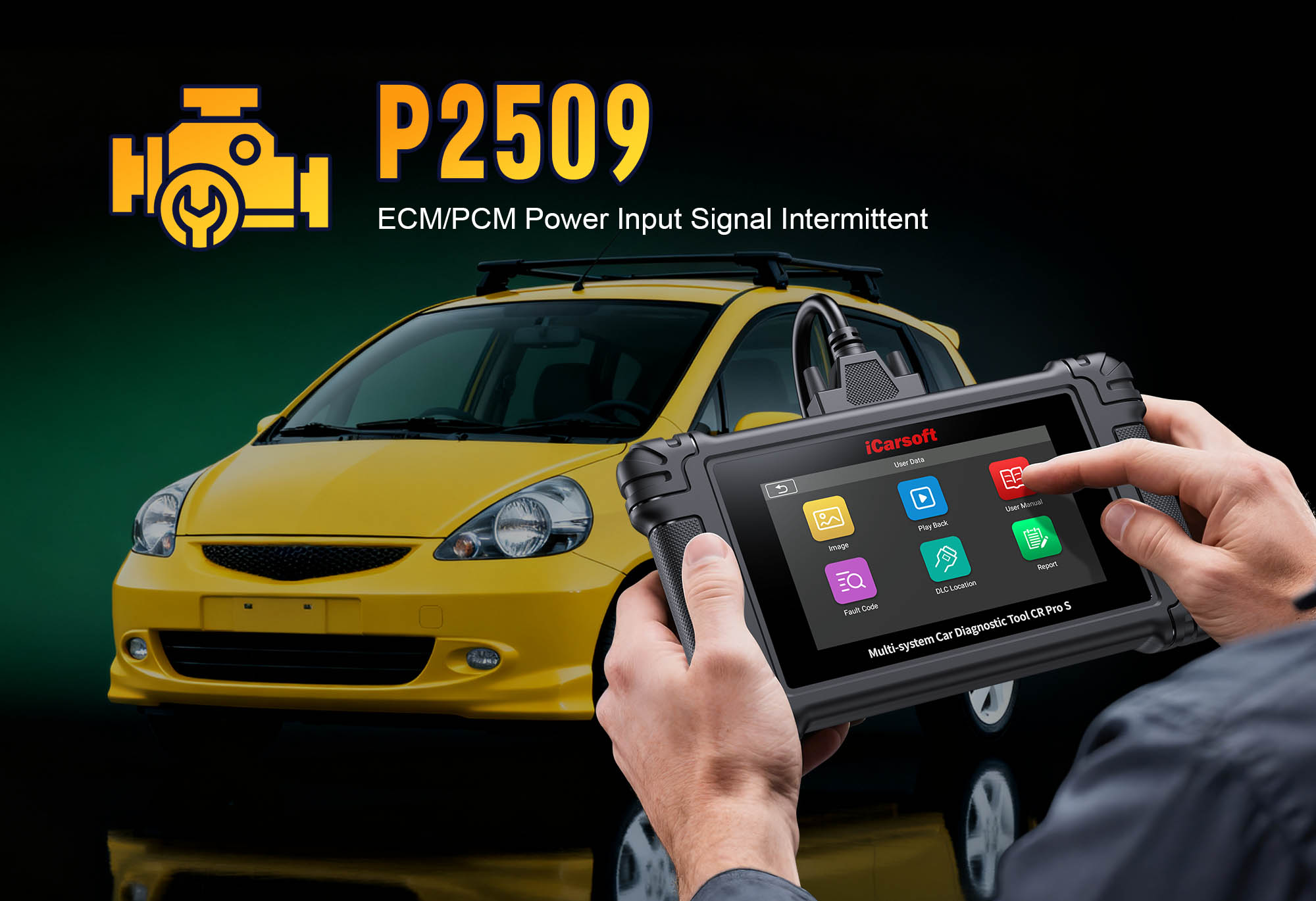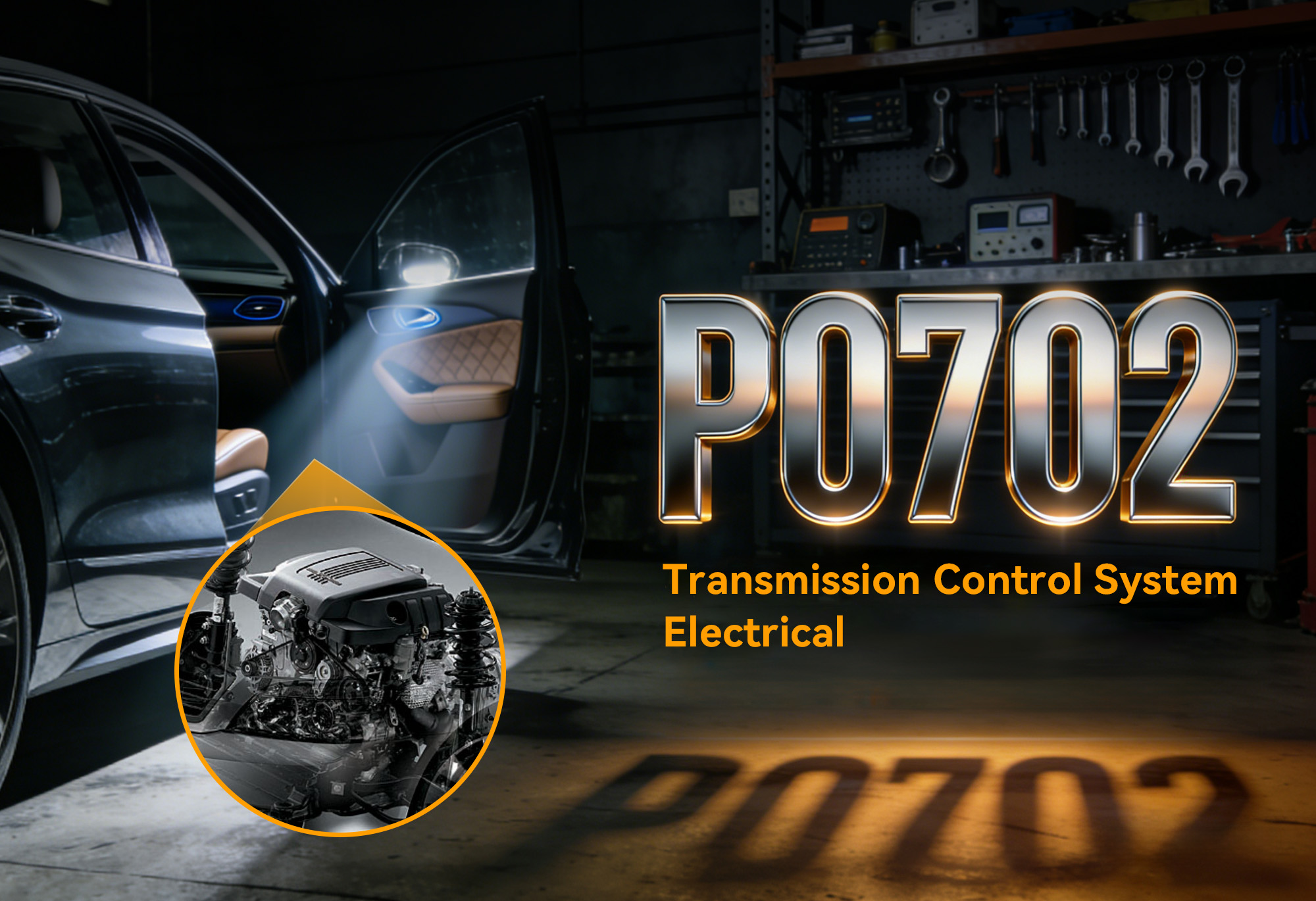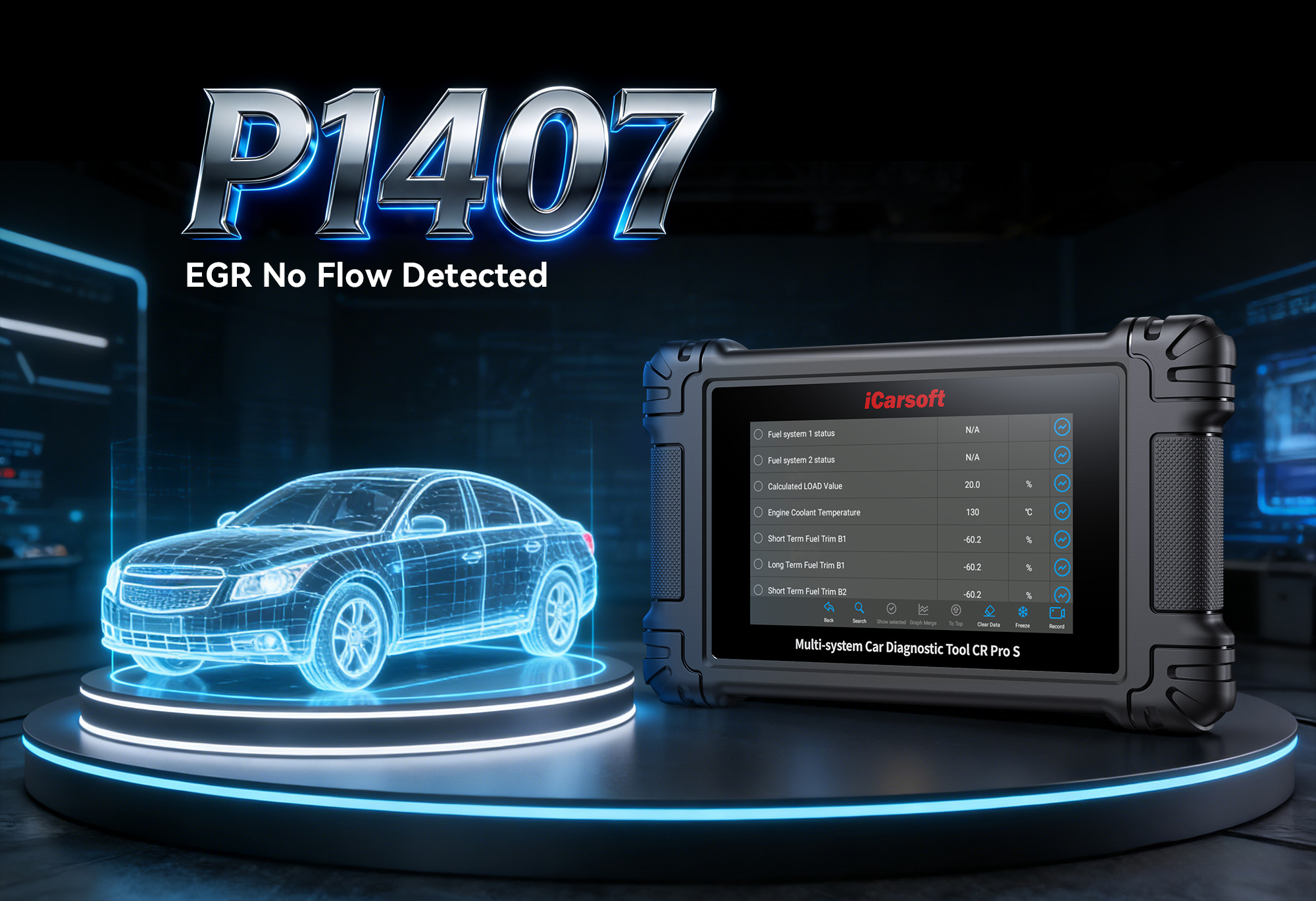P2509 Code: Diagnose & Clear Charging System Voltage Low with iCarsoft CR Pro S
If your vehicle’s check engine light illuminates and you notice dimming headlights, slow cranking, or a dead battery, a diagnostic scan will likely return P2509. This OBD-II code stands for "Charging System Voltage Low," indicating the Engine Control Module (ECM) has detected that the alternator is failing to maintain proper electrical system voltage (typically below 12.0V, vs. the normal 13.5–14.5V when the engine is running).
The charging system—composed of the alternator, battery, voltage regulator, and wiring—keeps the battery charged and powers electrical components (lights, radio, ECM) while the engine runs. The ECM monitors voltage via sensors; if it drops too low, P2509 triggers. Left unaddressed, this can lead to a dead battery, stalling, or even complete electrical failure—leaving you stranded.
Basic scanners may only flag "low voltage" but can’t isolate whether the issue is the alternator, battery, regulator, or wiring. The iCarsoft CR Pro S, with its charging system diagnostics, live voltage tracking, and component tests, solves this. Let’s walk through how to diagnose and resolve P2509 with precision.
Understanding P2509: Causes & Key Symptoms
A failing charging system disrupts electrical power, with symptoms that worsen as voltage drops—these clues help separate battery, alternator, or wiring faults.
Key Symptoms of P2509
-
Dimming Headlights/Interior Lights: Lights flicker or grow dim at idle (when alternator output is lowest).
-
Slow or No Cranking: The battery lacks charge to start the engine, especially after short drives (alternator doesn’t replenish charge).
-
Electrical Component Malfunctions: Radio cuts out, power windows move slowly, or "Battery/Charging System" warning lights activate.
-
Stalling While Driving: Voltage below 9.6V disrupts ECM operation, causing the engine to shut off unexpectedly.
-
Dead Battery: The battery drains completely after sitting, as the alternator fails to maintain its charge.
-
Intermittent Issues: Symptoms come and go—often from loose alternator belts, corroded terminals, or a failing regulator.
Common Causes of P2509
|
Cause
|
Description
|
|
Failing Alternator
|
Worn brushes, faulty stator, or broken diode reduce output—common in vehicles over 100,000 miles.
|
|
Weak/Dead Battery
|
A battery with bad cells can’t hold a charge, overworking the alternator and causing undercharging.
|
|
Loose/Damaged Alternator Belt
|
A slipping belt (from wear/misalignment) lowers alternator speed, reducing voltage output.
|
|
Corroded Terminals/Wiring
|
Rust or oxidation on battery/alternator terminals blocks current flow, lowering system voltage.
|
|
Faulty Voltage Regulator
|
The regulator (built into most alternators) fails to control output, leading to undercharging.
|
|
ECM Malfunction
|
Outdated firmware or internal faults cause the ECM to misinterpret voltage readings—rare in most vehicles.
|
Why iCarsoft CR Pro S Excels at Diagnosing P2509
The CR Pro S outperforms basic tools with charging-system-specific features, critical for isolating the root cause of P2509:
Live Voltage Monitoring
Tracks battery, alternator, and system voltage in real time—spots drops below 13.5V instantly.
Charging System Load Tests
Simulates electrical demand (lights, AC, wipers) to test alternator performance under stress.
Battery Health Analysis
Tests battery capacity and cranking amps—distinguishes between battery and alternator faults.
Component Circuit Checks
Verifies continuity/resistance in alternator wiring/terminals—catches corroded or frayed cables.
Global Vehicle Coverage
Works with 500+ models (gasoline, diesel, hybrid) from Toyota, Ford, BMW, Mercedes-Benz, etc.
ECM Voltage Calibration
Resets/re-calibrates ECM voltage monitoring—fixes false P2509 triggers from software glitches.
Step-by-Step: Diagnose P2509 with iCarsoft CR Pro S
-
Check Battery Voltage & Physical Condition
1. Visual Inspection: Look for battery bulging, terminal corrosion (white/green powder), or loose cables. Clean terminals with a wire brush + baking soda solution.
2. Static Voltage Test: Turn off engine/accessories. Use CR Pro S’s Battery Voltage Test (System > Tools): Normal = 12.4–12.7V. <12.4V = undercharged; <12.0V = bad cell.
-
Connect the CR Pro S & Confirm the Code
1. Plug the CR Pro S into the OBD-II port. Power on and select your vehicle via Auto VIN Identify (instant specs) or manual entry.
2. Navigate to Engine > Fault Codes > Read Codes to confirm P2509. Tap Code Details for tips (e.g., "Toyota Camry: Target Alternator Voltage = 13.5–14.5V").
-
Locate Charging System Components
1. Go to Component Location > Engine > Electrical > Charging System.
2. Use the diagram to identify:
- Alternator: Engine-mounted with a belt pulley, connected to battery via thick red cable.
- Battery: Under hood (or trunk for luxury models) with +/– terminals.
- Voltage Regulator: Built into alternator (most vehicles) or separate near ECM.
- Wiring Harness: Cables between alternator, battery, and ECM (check for heat damage).
-
Analyze Live Charging System Data
1. Start the engine, idle, and turn on accessories (lights, AC, radio) to add load.
2. Navigate to Engine > Live Data > Charging System and monitor:
- Alternator Output Voltage: Normal = 13.5–14.5V. P2509 = <13.0V (undercharging).
- Battery Voltage (Running): Should match alternator output (±0.5V). Gap >1V = high resistance in cables.
- Alternator Load %: Normal = 30–70% under load. Consistently >90% = overworked (failing).
- Regulator Signal: Steady voltage (typically 5V). Erratic = regulator/ECM fault.
-
Perform a Charging System Load Test
1. Go to Special Functions > Engine > Charging System > Load Test.
2. Follow prompts: CR Pro S cycles high-demand scenarios (all lights, AC max, defroster).
3. Monitor results:
- Stays 13.5–14.5V = Alternator good (issue = battery/corrosion).
- Drops <13.0V = Alternator failing (needs replacement).
-
Test Alternator & Voltage Regulator Function
1. Alternator Bench Test: - Remove alternator (use Torque Guide). Test at parts store or with multimeter: Spin pulley → 13.5–14.5V at 1,500 RPM. No output = faulty.
2. Regulator Test: - Internal regulator: Failing = output <13.0V (replace alternator). External regulator: Test resistance (specs vary) → erratic = replace.
-
Inspect Wiring, Belts, & Grounds
1. Wiring/Terminals: - Check alternator-battery red cable for fraying. Measure resistance (normal = <0.5 ohms). High = replace cable.
2. Ground Cable: - Inspect alternator-to-engine block ground. Loose = tighten; corroded = replace.
3. Alternator Belt: - Check tension (deflects 1/2 inch when pressed). Squeals at startup = adjust/replace.
-
Rule Out ECM Issues
1. ECM Firmware Update: - Go to System > Update Manager to install free updates (fixes misinterpreted voltage data).
2. ECM Voltage Calibration: - Use Special Functions > ECM Calibration > Voltage Monitoring to reset parameters.
-
Repair & Clear P2509
1. Fix the root cause:
- Failing Alternator: Replace with OEM/quality unit (use Part Lookup).
- Weak Battery: Replace (match vehicle’s CCA rating).
- Wiring/Belt: Clean terminals, replace cables, or adjust/replace belt.
- Regulator/ECM: Replace alternator (internal reg) or update ECM firmware.
2. Clear the code: Navigate to Engine > Fault Codes > Clear Codes to delete P2509.
-
Validate the Repair
1. Recheck live data: Alternator output = 13.5–14.5V at idle/under load.
2. Test drive 30+ minutes (use accessories): No dimming lights or warnings.
3. Post-drive battery check: Turn off engine, wait 1 hour → voltage >12.4V (holds charge).
4. Scan after 50 miles: Use Charging System Scan to confirm P2509 doesn’t return.
Preventing P2509 Recurrence
Use the iCarsoft CR Pro S to maintain charging system health long-term:
-
Battery Maintenance: Set Service Reminder to test the battery every 6 months. Replace every 3–5 years (sooner in cold climates).
-
Alternator Checks: Include alternator output in annual electrical scans—catch early undercharging (13.0–13.4V) before P2509 triggers.
-
Terminal Care: Clean battery/alternator terminals yearly with a wire brush + anti-corrosion spray.
-
Belt Inspections: Check belt tension/condition every 15,000 miles—replace if cracked or glazed.
Conclusion
P2509’s low charging system voltage is more than an inconvenience—it’s a warning of potential breakdowns. The iCarsoft CR Pro S simplifies diagnosis with live voltage tracking, load tests, and component checks, ensuring you fix the root cause (alternator, battery, or wiring) instead of guessing.
With the CR Pro S, you’ll restore reliable electrical power, avoid dead batteries, and keep your vehicle running smoothly—no more unexpected stalls or costly towing fees.
FAQs About P2509 Code
Q: Can I drive with P2509?
A: Only short distances (e.g., to a repair shop). Prolonged driving drains the battery, leading to stalling. Address P2509 within 1–2 days.
Q: How much does it cost to fix P2509?
A: $150–$300 for a battery; $300–$800 for an alternator (parts + labor); $50–$200 for wiring/belt repairs. The CR Pro S ($300–$400) saves by avoiding unnecessary alternator replacement.
Q: Why does P2509 come back after clearing?
A: The root cause wasn’t fixed—e.g., a bad battery was recharged (not replaced) or corroded terminals weren’t cleaned. Use the CR Pro S’s live data to recheck after clearing.
Q: Will jump-starting fix P2509?
A: Jump-starting only temporarily charges the battery—it won’t fix the underlying issue (failing alternator, bad wiring). P2509 will return until the root cause is resolved.





